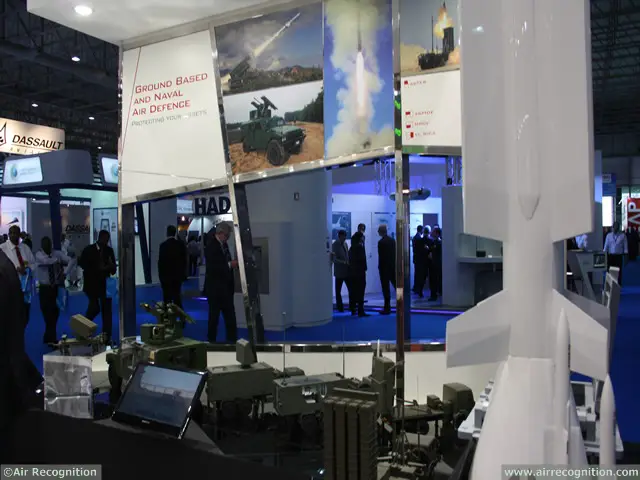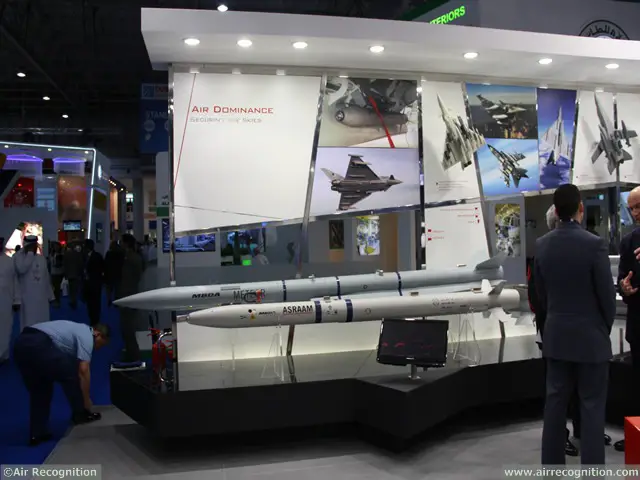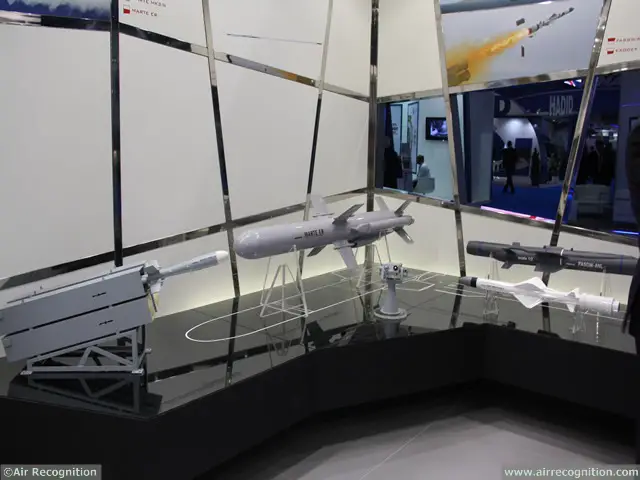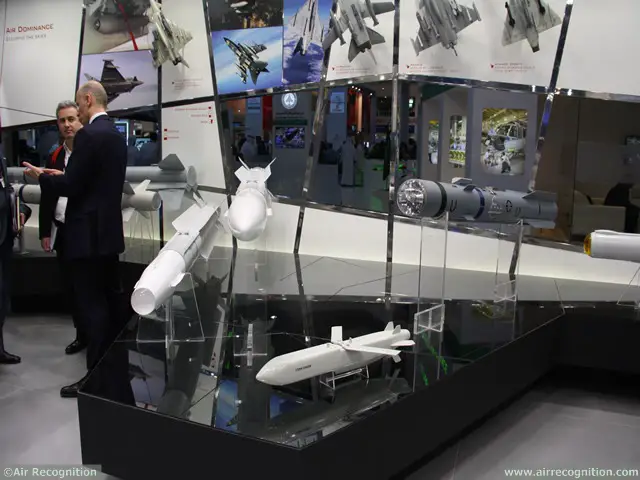Air Launched Weapons
As Europe’s leading supplier of guided weapons, MBDA is closely
associated with the latest generation of European air platforms such
as Rafale and Eurofighter, as well as the Mirage 2000 which has been
in service for some time with the air forces of Qatar and the UAE. To
maximize the operational performance of these exceptional aircraft and
to provide them with a true multi-role capability, MBDA offfers a range
of air-to-air and air-to-surface products.
METEOR will provide the key future BVR (Beyond Visual Range) air-to-air
armament for Europe’s new generation of combat platforms such
as the Eurofighter Typhoon, the Rafale and the Gripen. This missile’s
very long range, combined with its ramjet-induced speed, result in a
weapon that has an unequalled No Escape Zone. In fact METEOR has been
designed to be many times superior to the most sophisticated of current
and emerging BVR missile capabilities. The advanced technology contained
within METEOR controls speed and fuel consumption throughout the flight
envelope. This ensures that maximum power and hence agility are maintained
at the extremes of range where other BVR missiles have long since ceased
being effective.
MICA features on the Mirage and is also in service on the French Air
Force and French Navy’s Rafale. Showcased on MBDA’s stand,
this is the only missile in the world featuring two interoperable seekers
(active radar and imaging infrared) to cover the spectrum from close-in
dogfight to long beyond visual range ASRAAM’s unmatched speed
and agility guarantees “first shot first kill” in short
range combat to avoid the need of getting involved in the lottery of
a dogfight. This very aerodynamically sleek missile is in service on
the UK RAF’s Eurofighter Typhoons and the Royal Australian Air
Force’s F/A 18s.
STORM SHADOW/SCALP provides the all-important operational capability
of delivering precision effects from a safe stand-off distance against
high value targets such as well protected control bunkers/centres, key
infrastructures and military installations, crucial targets in the early
days of a conflict. Qualified on a range of aircraft, STORM SHADOW/SCALP
is in service with the air forces of six different nations and has proven
its unerring and unmatched ability under combat conditions.
DUAL MODE BRIMSTONE
(DMB) has won international acclaim following its successful combat
deployment during recent operations in Libya and Afghanistan. Precision
surface strikes are a major feature of today’s air force mission
and DMB with its dual millimetric wave radar and semi-active laser (SAL)
seeker gives the pilot the level of flexibility needed for the most
demanding of modern missions, either in open terrain or in complex urban
environments.
Anti-Ship Weapons
MARITIME BRIMSTONE, this radar seeker equipped Brimstone has been tested
and proven as a highly effective surface-to-surface weapon in response
to the growing threat in the littoral where ships, off-shore oil platforms
and other valuable assets are at risk from piracy and especially a new
category of naval threat referred to as the FIAC (Fast Inshore Attack
Craft). This FIAC threat is hard to deal with as it usually involves
a number of small, well-armed craft travelling at high speed in a sudden
swarming attack. A ship’s guns cannot provide an adequate defence
nor will laser beam riding weapon systems. However, MARITIME BRIMSTONE
(sometimes referred to as Sea Spear) can be fired in rapid salvos in
fire-and-forget mode to stop the FIAC threat regardless of weather or
sea conditions. The weapon is also adding its capability to MBDA’s
CWSP (Compact Warfare System Package) system which along with the company’s
Marte MK2/N anti-ship weapon and the SIMBAD RC air defence weapon combine
to provide OPVs and auxiliary ships with a fully integrated and easy
to use capability to meet modern maritime challenges.
MARTE is proof of how MBDA specialises in system modularity and product
evolution to meet growing customer requirements. This is typically the
case with the MARTE family of missiles with its ship and helicopter
launched variants. The MARTE MK2/S system has already been integrated
and qualified on the medium-range NH90 helicopter. MARTE MK2/N offers
the same missile but launched from a ship deck (from OPVs and upwards
– see CWSP above)). Easily installed on a new build or as a retro
fit, the weapon can be fired from a number of launcher configurations.
The most recent evolution is MARTE ER with a larger warhead and an extended
range out to 120km. It is suitable for a wide range of helicopters but,
significantly, six of these weapons can be carried by the Eurofighter.
EXOCET probably ranks as the world’s best known anti-ship missile.
This highly versatile and effective weapon family will be represented
in full on MBDA’s stand with the AM39 air-launched, the SM39 submarine-launched
and the latest addition to the family, the 200km class MM40 Block 3
ship and coastal battery-launched missile prominently displayed.
FASGW/ANL is being developed to provide navies with a next generation
helicopter launched weapon with a maritime and land target set that
covers the spectrum from FIAC to Corvette and typical littoral land
targets. Its main capability will be aimed at sinking or disabling Fast
Attack Craft (FAC) in the 50 to 500 tonne class. The new weapon will
be integrated with a range of platforms over time such as the UK’s
AW159 Wildcat naval helicopter, the French Navy’s Panther and
eventually the NH90. The weapon will benefit from imaging infra-red
guidance with associated data linking, allowing the operator to positively
identify the target and maintain Man-In-The-Loop control during a mission,
an important feature with regard to current rules of engagement which
are especially demanding in the complex littoral environment.
OTOMAT, deployed
by several navies around the world, has been upgraded into the MK2 Block
IV variant to further enhance the missile’s capability in the
littoral environment as well as its already impressive capability to
penetrate a targets soft and hard kill defences. This new variant which
entered service with the Italian Navy in 2007 features on its new FREMM
multi-mission frigates.
Naval and Ground Based Air Defence
ASTER 30 has proven its capabilities during recent test firings. Not
only has it registered Europe’s first successful intercept of
a target representing a ballistic missile it has also shown its ability
to defeat one of the most dangerous of naval threats – the supersonic,
sea skimming anti-ship missile. ASTER is in service with the French,
Italian and UK navies providing the main defence system for their latest
frigates and destroyers. It is also in full operational service with
France and Italy as a ground based system. A full scale model will be
prominently displayed on MBDA’s stand.
MISTRAL has proven its unmatched capabilities with a 96% success rate
in all firings. This highly versatile fire and forget IR missile features
in a number of air defence systems for both naval and land applications.
This versatility will be displayed on MBDA’s stand with two relatively
new concepts – MISTRAL SIMBAD RC (see also CWSP) and the MISTRAL
MPCV. The former is a remote controlled development of the original
SIMBAD system. MPCV, which has been ordered by a customer in the Gulf,
also features a twin MISTRAL launcher but mounted on a highly mobile
armoured vehicle.
VL MICA provides clear evidence of the flexibility of MBDA weapon systems.
Deploying the same missile that equips Mirage and Rafale aircraft for
the air-to-air role, the vertically launched VL MICA system is already
in service in its naval and ground based versions and has been ordered
by four export customers. The Royal Navy of Oman recently carried out
a successful operational naval VL MICA firing from one of its Khareef
class OPVs, the Al Shamikh).
SPADA 2000, in service with a customer in the Gulf, is an advanced,
ground based missile system capable of operating in dense ECM environments
to provide all weather, day and night area defence against combat aircraft
and incoming missiles. The operational performance of the ASPIDE 2000
missile allows the system to engage air threats at ranges well beyond
other VSHORAD missiles.
Solutions For The
Battlefield
MBDA has held a strong position in the ATGM market place with the MILAN
system still in service with many armies around the world. Looking to
the future, which sees a more networked battlefield, MBDA is able to
offer the latest generation capabilities to carry out missions against
armoured vehicles and a range of other ground targets, fast moving or
static. In this respect, full scale models of MBDA latest developments
in this field, MILAN ER and MMP will be displayed on the company’s
stand.
MILAN ER is the
latest evolution of the world renowned MILAN weapon used by armies around
the world. Actually this latest MILAN weapon is more of a step change
than an evolution given the features that are now included. MILAN ER
features an easy to use digitized firing post and extended range missile.
Digitisation gives MILAN the capability of being incorporated within
a Network Centric Warfare system if so required. Despite all the advances
(such as video inputs/outputs for remote control operation) incorporated
in the firing post, previous generations of MILAN munitions can still
be used. The new ER munition has a range of 3,000m and an enhanced warhead
to combat even the latest battle armour. Though representing a major
advance in close combat support weaponry, MILAN ER is still extremely
robust and training and maintenance remains very straightforward.
MMP, recently given the go ahead by the French government is a man-portable
system that can also be installed on tracked or wheeled vehicles. Suitable
for a wide range of moving and static ground targets, including the
latest generation main battle tanks, MMP features a range up to 4,000m
and the options of fire-and-forget or man-in-the-loop launch. It also
being designed for deployment within a networked environment.
PARS 3 LR is being delivered to the German Army to provide its Tiger
helicopters with the capability of targeting and defeating a wide range
of mobile and stationary ground targets from latest generation armour-protected
vehicles to bunkers with pinpoint accuracy. For pilot safety, the fire-and-forget
missiles, once launched, navigate autonomously to their respective targets
without requiring further input from the gunner thereby allowing the
helicopter to quit its position should there be a danger.
























